William Hill Darker, ca. 1811 - 1864
by Brian Stevenson and Howard Lynk
last updated April, 2021
Adapted and expanded from Stevenson & Lynk (2016) William Hill Darker: The scientists’ engineer, Quekett Journal of Microscopy, Vol. 42, pages 559-579
William Hill Darker was a highly respected manufacturer of scientific instruments, with a clientele that included many of the top physics researchers of his era. He had an evident enthusiasm for investigations of light. Darker also produced well-regarded microscope slides, with an emphasis on objects for polariscopic viewing, such as mounts of minerals, fossils, and woods (Figure 1). He was a charter member of the Microscopical Society of London (later, the Royal Microscopical Society).
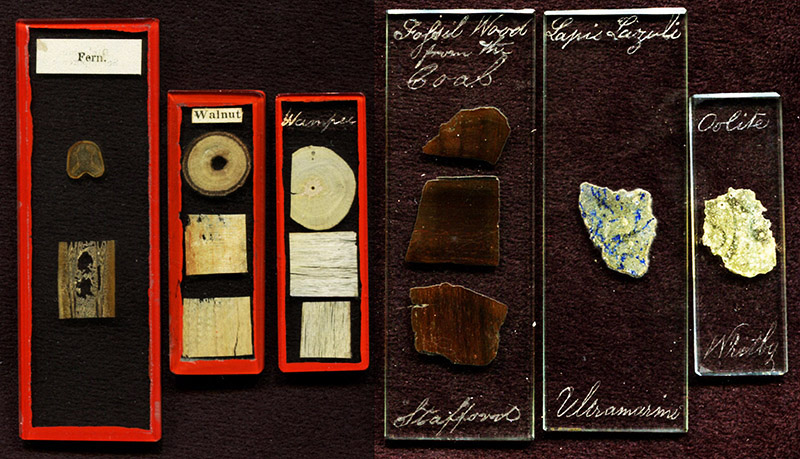
Figure 1.
Examples of microscope slides attributable to William H. Darker. The three on the left are dry mounts of sectioned botanical subjects, the leftmost of which is standard 1x3 inch size, the other two are smaller “continental” sized slides. All three are prepared from two glass slides of equal thickness, sealed with red wax. Although later opinion suggested that such slides were prepared by Andrew Pritchard, contemporary sources point to Darker as the maker. The third slide from the left, of Wangee cane, bears Darker’s handwriting etched into the glass. The three slides on the right are thin-sections of minerals. Darker generally wrote the source of his minerals on such slides. All these slides are very finely finished, with polished and chamfered edges. Darker was greatly esteemed for the precision of his work, both in microscope slides and in scientific apparatus.
Prologue
“It was my custom some years ago, whenever I needed a new and complicated instrument, to sit down beside its proposed constructor, and to talk the matter over with him. The study of the inventor's mind which this habit opened out was always of the highest interest to me. I particularly well remember the impression made upon me on such occasions by the late Mr. Darker, a philosophical instrument maker in Lambeth. This man's life was a struggle, and the reason of it was not far to seek. No matter how commercially lucrative the work upon which he was engaged might be, he would instantly turn aside from it to seize and realise the ideas of a scientific man. He had an inventor's power, and an inventor's delight in its exercise.” John Tyndall, 1879.
“Darker is by far the best man to go to for anything of the sort but he keeps people waiting for 18 months or 2 years.” William Crookes, February 28, 1861 (quoted in James, 1981).
“Can you tell me whether Darker is living or dead or what has become of him? I have been writing letter after letter to him, without receiving any answer, and have been most excessively put about by not receiving a quantity of apparatus which he promised to let me have, I can’t tell you how long ago. I am now in very great straits for want of it, & I have written again & again asking him to let me have an immediate answer and to send me without any delay such of the apparatus as he has ready. I shall be much obliged if you will tell me what you know of him now, & if you will, if you see him or write to him about your own business, ask him to communicate with me. I cannot tell you how much inconvenience I am suffering just now nor how impatient I am under Mr. Darker’s treatment which is such as I have never experienced from any instrument maker, or any body else, before. I am very sorry to trouble you by writing about it, but I do so as a forlorn hope of getting Mr. D. stirred up.” William Thompson (Lord Kelvin) to Sir George Stokes, March 8, 1852 (quoted in Wilson, 1990).
Darker’s Early Years
Census and other records are fairly consistent in dating William Hill Darker’s birth between April, 1811 and April, 1812. He was born in Walworth, Surrey, England, to William Hill Darker Sr. and Mary Clay Darker. His parents had married on March 9, 1811. The elder Darker was originally from Leicestershire. Around the time of son William’s birth, he and a partner owned a “paper staining” business, i.e. a factory that produced patterned wallpaper, marbled paper, or other types of colored paper. The business was located on Millman Row, Chelsea, and the partnership dissolved in 1813. London tax records from 1814 list W.H. Darker as still living within the parish of St Luke, Chelsea.
The Darker family moved to Lambeth, Surrey by 1823, as tax records show “William Hill Darker” occupying property on the Estate of the Archbishop. They were still in that town in 1828, occupying a house owned by one J. Crooke.
William Darker worked alongside his father until the latter’s death. William Sr. was consistently described in census records as being a “chemist” or “operative chemist”. He would, therefore, have been a manufacturer and retailer of chemicals. Samuel Gray, in his 1828 The Operative Chemist, wrote, “Besides the workshop, every operative chemist ought to devote some part of his premises as a small general laboratory, fitted up with such furnaces and other apparatus as may enable him to make any experiment seemingly applicable to the improvement of his manufacturing processes without loss of time, and immediately upon its conception”. Their output indicates that the Darkers’ operation was set up in such a manner, with both production and experimentation taking place. The father’s expertise extended well beyond chemistry, as both Darkers and a “carpet-manufacturer” named William Wood were granted an 1841 patent “for certain improvements in looms for weaving” (Pritchard, 1842). Growing up in such a creative environment would have provided William Darker with the intellectual skills that were evident throughout his career.
The right man in the right place at the right time
During Darker’s youth, discoveries and inventions in Scotland were revolutionizing geology, paleontology, and optics. Within a few years, those developments would also dramatically change microscopy in general, and shape major aspects of William Darker’s livelihood.
In 1828, William Nicol (1770-1851) announced an invention that would, “prove interesting to those who are in the habit of examining the optical properties of crystallised bodies by polarised light”. He described production of his new prism as, “a rhomboid of calcareous-spar … divided into two equal portions, by a plane passing through the acute lateral edges, and nearly touching the two obtuse solid angles. The sectional plane of each of the two halves must now be made to form exactly an angle of 90° with the terminal plane, and then carefully polished. The two portions are now to be firmly cemented together by means of Canada balsam, so as to form a rhomboid similar to what it was before its division” (Nicol, 1828). The use of Canada balsam in Nichol’s prism is very important, as the adhesive not only sets solidly, but also has a refractive index similar to that of glass, and therefore does not noticeably affect the transmission of light.
A decade or so earlier, an Edinburgh lapidary, George Sanderson (1792-1847), had developed a method for producing thin-sections of minerals. Sanderson’s method was described as “one of some difficulty and uncertainty. To succeed in it, we must first grind a surface flat and then with lapidary's cement fix that surface to a block of wood, by means of which the fossil can be again ground down until considered thin enough. But then it is difficult to detach the fossil from the block, and to remove the cement without breaking it” (Nicol, 1834; Leifchild, 1860).
Nicol improved upon Sanderson’s technique by using Canada balsam instead of cement. A major advantage is that a specimen will easily detach from the preparation surface by heating and melting the balsam. Nichol also affixed the specimen to a piece of clear glass, instead of wood. He wrote “When I first began to prepare such sections, I had recourse to a process I had practised upwards of fifteen years ago, in preparing thin slices of the most fragile substances, as calcareous spar, in order to examine their effects on polarised light. My process was simple and of easy execution, and consisted of cementing with duly concentrated Canada balsam, the flattened surface to a piece of plate glass, and then grinding down with emery on a plate of copper. The glass and cement being both transparent, I could, with certainty, determine when I had arrived at the proper degree of thinness, and, when that was attained, nothing more was requisite than to polish the surface. At Mr. Witham’s request, I wrote a full account of all the manipulations requisite in my method of preparing thin fossil sections, which is printed towards the end of that gentleman’s work.” (Nicol, 1834).
Nicol collaborated with Henry Witham (1779-1844) on microscopical investigations of fossil woods from coal deposits. In 1831, Witham published a book on the subject, Observations on Fossil Vegetables Accompanied by Representations of Their Internal Structure as Seen Through the Microscope. Although Witham dedicated the book to Nicol and credited him with developing the thin-section techniques, that method became widely known as “Witham’s method”. This and other slights created a chasm between the two men, which have been ably described elsewhere (e.g. Falcon-Lang and Digrius, 2014). Witham’s instructions concluded that, “A lapidary, by attending to the above directions, will find no difficulty in reducing any piece of petrified wood to that degree of thinness sufficient to render its structure visible; and any one, even without the aid of the mechanism employed by the lapidary, may accomplish that object by attending to the following directions” (Witham, 1831)
A large number of amateur and professional men soon followed Witham’s advice, as recently described by Falcon-Lang and Digrius (2014). Relating to this, Falcon-Lang and Digrius speculated that Charles Topping learned lapidary techniques during an apprenticeship with William Darker. We found no evidence of such an apprenticeship, which would have been unlikely: Topping was about 10 years older than Darker, and was 42 years of age when Witham published his book. Instead, Topping probably worked out how to make thin sections on his own.
While those advances were occurring in Edinburgh, John Thomas Cooper (1790-1854) of London was making significant impacts on microscopy and other scientific fields. Cooper described himself as a “teacher of chemistry, and analytical mineralogy” (Cooper, 1820). Cooper also operated retail businesses at 76 Drury Lane in 1815, and at 89 Strand in 1818, then moved across the Thames in 1820, to 9 Paradise Street, Lambeth. He was a long-time member of the Geological Society and the Chemical Society, and so was well-acquainted with notables such as Michael Faraday, William Buckland, and Charles Lyell. His scientific and engineering skills were well recognized. For example, in 1823, The Society of Arts and Sciences awarded prizes to Cooper, “for his improvements in the apparatus for analysing vegetable and animal substances, the large silver medal. To the same, for a hydrometer for saline solutions, the gold Vulcan medal” (London Journal of Arts and Sciences, 1823). One of Cooper’s apprentices was Robert Warington, later the inventor of the household aquarium and a member of the Royal Microscopical Society, whose entry on the Dictionary of National Biography states, “In November 1822, after a year's trial, he was articled for five years to John Thomas Cooper, a lecturer in the medical schools of Aldersgate Street and Webb Street, and a manufacturer of potassium, sodium, iodine, and other then rare chemical substances” (Hartog, 1899). Cooper was also deeply involved with studies on the nature of light, and on the use of oxygen and hydrogen combustion as a light source (London Mechanics’ Register, 1826, and Cooper, 1831). In 1833, Cooper partnered with John Cary (1754-1835), who had inherited his brother William’s microscope business, to open a public exhibition of oxy-hydrogen illuminated projection microscopy (Times, 1833).
Cooper’s interests in geology and microscopy undoubtedly familiarized him with the use of Canada balsam as a fixative for Nicol prisms. It would have been a logical step for him to try embedding insects and other objects in clear, solid balsam. James Bowerbank attributed that important development to John Cooper, circa 1832. Cooper then shared the method with professional slide makers James W. Bond and John New (Bowerbank, 1870; Davidson, 2009; Stevenson et al., 2010).
The Darkers’ business at 9 Paradise Street, Lambeth
Cooper remained in Lambeth until at least 1834. He was listed as operating from 9 Paradise St. in that year’s prospectus of the Theatre of Anatomy and Medicine, London. Shortly afterwards, Cooper moved to 82 Blackfriars Road, London, as demonstrated by a paper on hydrocyanic acid that he published from Blackfriars on Feb. 1, 1836. His son, Daniel, wrote a botanical paper from Blackfriars during Nov., 1835, suggesting that the Coopers moved during 1834 or 1835.
The Darkers took over the Lambeth shop, probably directly from Cooper. Robson’s 1838 Commercial Directory of London listed “Darker, W.H., Op. Chemist, Paradise St., Lambeth”. The parish record of Darker’s 1838 marriage listed his address as “Church Row”, which was a major thoroughfare adjacent to Paradise Street.
Similarities between items known to have been manufactured by both Cooper and Darker suggest that young William, and possibly also his father, worked alongside Cooper prior to the business transfer. Among the optical devices developed and sold by Cooper were “selenite windows”, which create a variety of colors when viewed between crossed polarizers. The Museum of the History of Science, Oxford, holds a selenite window signed “J.T. Cooper, Fecit et Delt. October MDCCCXXXIV” (1834). Darker continued this trade, “by ingeniously connecting pieces of various thicknesses (in the same forms as stained glass for cathedral windows), the most beautiful designs were made by the late Mr. J.T. Cooper, jun., which have since been manufactured in great quantity and variety by Mr. Darker, of Paradise-street, Lambeth” (Pepper, 1860). J. Periera wrote of “Gothic windows, stars, flowers, fruits, animals (butterflies, parrots, dolphins and chameleons), and theatrical figures (Jim Crow, harlequin, &c.), are some of the ingenious, and often laughable illustrations contrived by Mr. Darker.” (Periera, 1854) (Figures 2A and 2B).
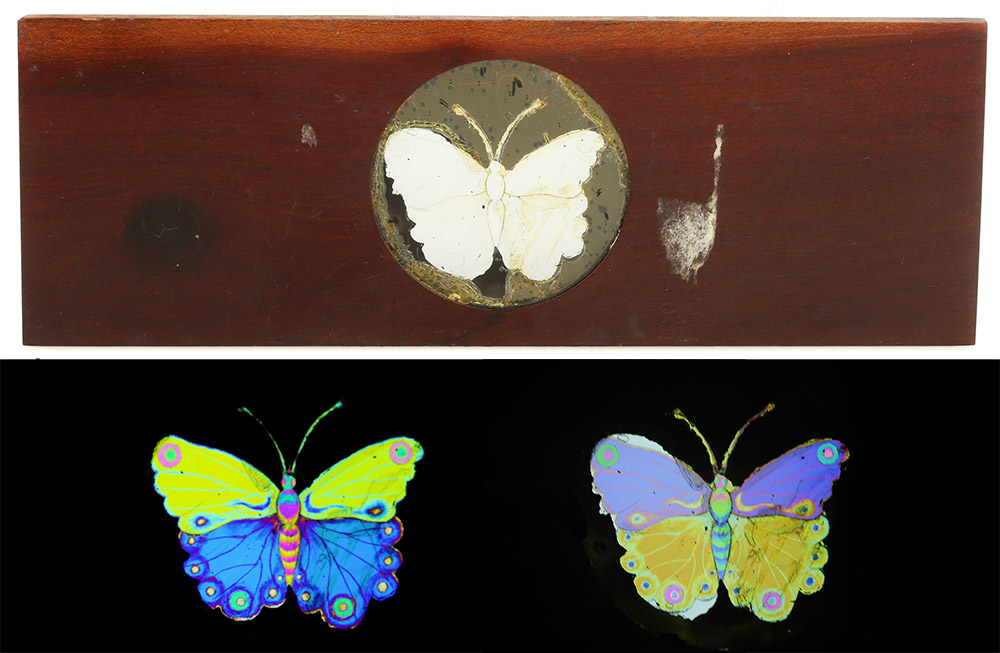
Figure 2A.
A lantern slide of a butterfly made from selenites, signed "W. Darker". In use, the slide would be mounted in a projection lantern (magic lantern) between crossed polarizing materials (probably Nichol's prisms), and the image projected onto a screen. Rotating one of the polarizing prisms would change the colors of the butterfly. Adapted for nonprofit, educational purposes from an internet auction site.
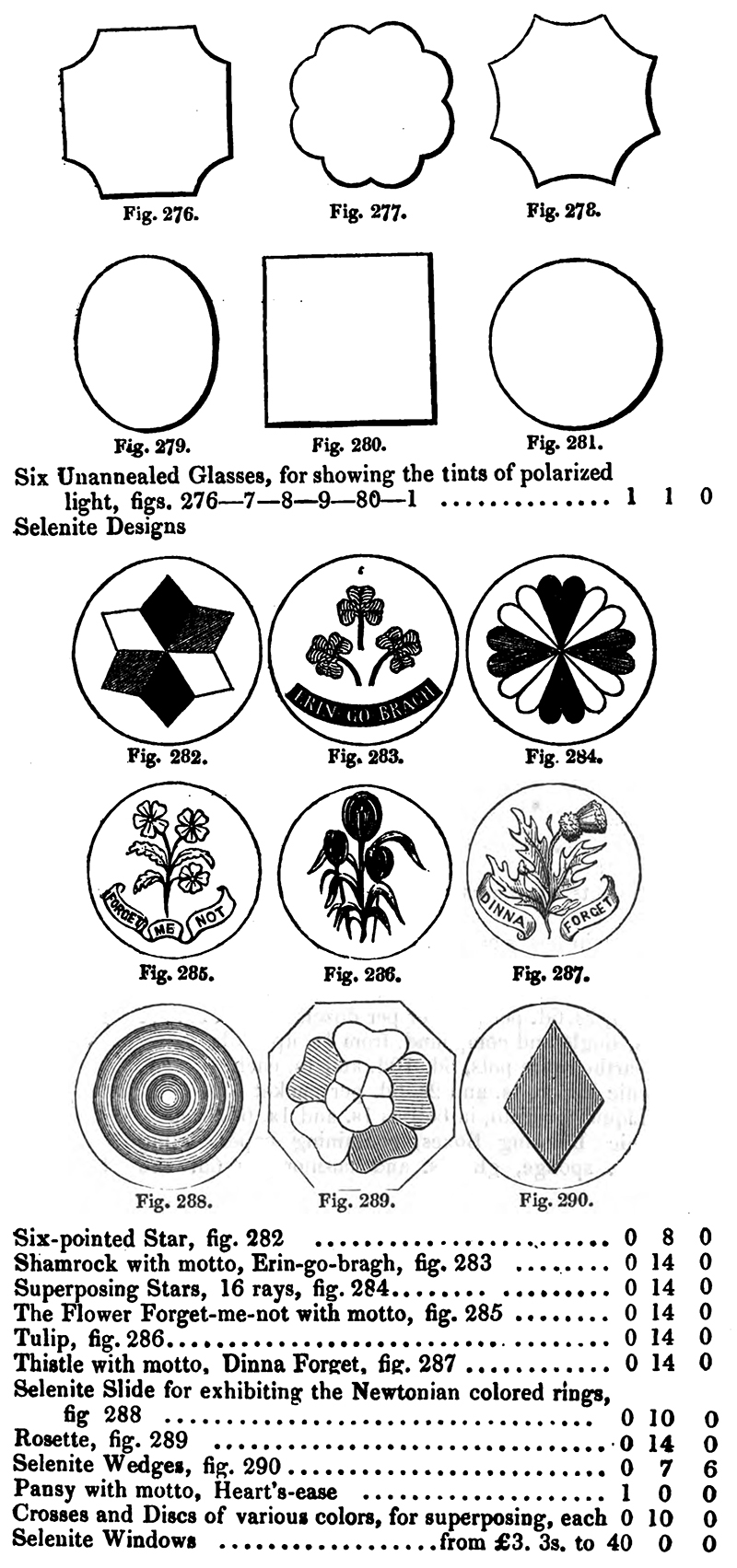
Figure 2B.
Illustrations of unannealed glasses and selenite windows, from the 1840 catalogue of Edward Palmer. Considering Darker’s reputation for commercially manufacturing such items, it is likely that he was the source of Palmer’s goods.
The earliest identified records of Darker as a manufacturer of optical devices date to time of the Lambeth business transfer. In 1836, the Adelaide Street Gallery exhibited “Objects Blending Instruction with Amusement”, including “A Polariscope, for showing the system of rings round the axes of certain crystals. By Mr. Darker”, “An Instrument for showing the different colours produced when films of selenite superpose each other in different crystalline positions. The vertical arms coinciding with the circle give the tint of their united thickness; the horizontal, crossing the circle, give the tint of their difference in thickness. Deposited by Mr. Darker”, and “Five pieces in series of unannealed Glass. Presented by Mr. W.H. Darker, Jun.” The latter were listed as “apparatus for experiments with polarized light”, which showed colored patterns “when seen through a tourmalin with a reflected light”. Inclusion of Darker’s materials in this exhibit imply that he had achieved expertise in their construction by the mid-1830s, further supporting the hypothesis that he received training from the highly experienced J.T. Cooper.
“W.H. Darker, jun., Esq.” presented lectures “on the Properties of Light, particularly its Polarization, and the Hydro-Oxygen Light as applied to Optical purposes”, at the London Mechanic’s Institution on August 2, 1839 (Mechanic and Chemist, 1839)
Darker exhibited “illustrations of action of polarized light on crystaline and other bodies” at the 1862 International Exhibition, and was awarded a Medal “for his preparations of crystals for investigations in physical optics” (International Exhibition, 1862). Robert Hunt’s Handbook to the Exhibition noted, “Mr. Darker, who is well known for the delicacy with which he manufactures apparatus and examples, is an exhibitor of a very nice series” (Hunt, 1862).
Those skills benefitted numerous scientists. Jonathan Pereira wrote in the introduction to his Lectures on Polarized Light, “To Mr. Darker, optician and manufacturer of polarizing apparatus, of Paradise Street, Lambeth, the thanks of the author are also justly due, for his disinterested zeal, skill, and attention in promoting the objects of the author in the preparation of the present course of lectures” (Pereira, 1843). George Field wrote in his Chromatics that, “those who wish assistance in their (polarized light) experiments may best obtain it from the intelligent and obliging Mr. W.H. Darker, of Paradise Street, Lambeth” (Field, 1845).
The Darker’s chemical and mineral products earned a reputation for quality. Michael Faraday evidently preferred them to the extent that he wrote this May 29, 1838 letter, “I was in hopes of receiving the crystals some time ago but am now very anxious for that of Carbonate of Lime as the investigation now wants for the experiments. Can you favour me with that one very soon?” (James, 1993). This is also the earliest known mention of the difficulty Darker sometimes had in fulfilling client orders in a timely manner. Nonetheless, Darker and Faraday developed a close association, with Darker frequently providing materials and operating his oxy-hydrogen projector for Faraday’s public presentations. For example, on January 23, 1846, “Prof. Faraday exhibited the great fact of his researches - the rotation of a ray of light by magnetic force. The well-known oxy-hydrogen light of Drummond supplied the ray. This light was so directed by an arrangement furnished by Mr. Darker, as to make distinctly visible, over the whole theatre, all the phenomena of circular polarization which were required to illustrate Prof. Faraday's newly-discovered principle” (Littell’s Living Age, 1846).
By the mid 1850s Darker’s expertise with these materials was without equal. Hogg’s 1858 3rd edition of "The Microscope", lists 2 pages of various crystals used for experiments in polarized light, ending with "Mr. Darker, 6 Princes Street (sic), Lambeth, is the only person in England who cuts the crystals properly".
In 1845, Darker was contracted by Charles Wheatstone to experiment with methods for producing undersea telegraph cables, “to enclose a copper wire insulated with worsted and marine glue in a lead pipe” (Proceedings of the Institution of Electrical Engineers, 1876). That venture was not ultimately successful, as Wheatstone eventually chose another supplier for his cables.
Wheatstone did, however, employ Darker to produce polarizing devices (Figure 3). Wheatstone developed several forms of instrument that could use the sun to tell time on cloudy days, which he called polar clocks, taking advantage of the facts that light from the sky is polarized, the plane of polarization depends on the position of the sun, and the solar-polarized plane rotates once every 24 hours (Bowers, 2001). On January 17, 1849, “Mr. Darker exhibited and explained Wheatstone's polar clock, by which the hour of the day can be determined in cloudy weather by polarized light” to the Pharmaceutical Society (Pharmaceutical Journal, 1849). Darker’s father was a member of that society, raising the possibility that the Darkers’ chemistry business extended to pharmaceuticals.
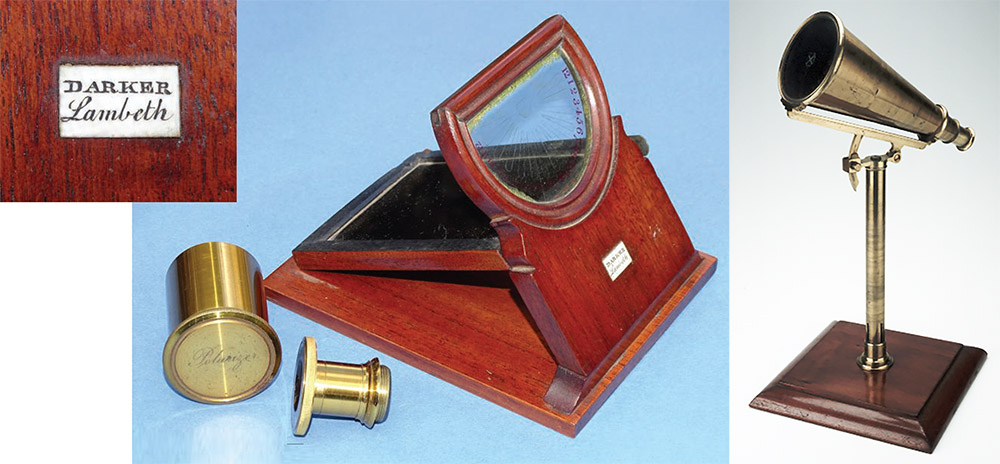
Figure 3.
Two components of “polar clocks”, manufactured by William H. Darker for Charles Wheatstone, circa 1848. The eyepiece of the item on the right is engraved “Darker Lambeth”. Adapted for educational, nonprofit purposes from an internet retail site and from a photograph from the Museum of the History of Science, Oxford, England.
Darker’s preparations for the microscope
An indication of Darker’s standing within the London scientific community is provided by the fact that he was one of only 40 individuals invited in 1839 to become charter members of the Microscopical Society of London (later, the Royal Microscopical Society) (Report, 1847).
Darker is probably best remembered today for his lapidary microscope slides of minerals and fossils (Figures 4 and 5). Like his other surviving products, Darker’s lapidary slides exhibit substantial efforts for excellence. His glass slides are prepared with the greatest attention to detail; all cut edges and corners were carefully ground, chamfered and polished. While this degree of finish was probably not necessary for Darker’s customers, it is consistent with other reports of Darker’s drive for perfection, and his tendency to focus on quality rather than maximizing income generation. During the 1840s, the only other commercial maker of lapidary slides considered comparable to Darker was Charles Topping. Topping’s slides from this early period also exhibit a time consuming attention to glass finishing. But, by the 1850s, Topping had adopted methods such as paper wrapping, which increased production rates by eliminating the need to finish rough edges. We have not found evidence of Darker following such cost-cutting methods to facilitate larger scale, more profitable marketing of preparations.
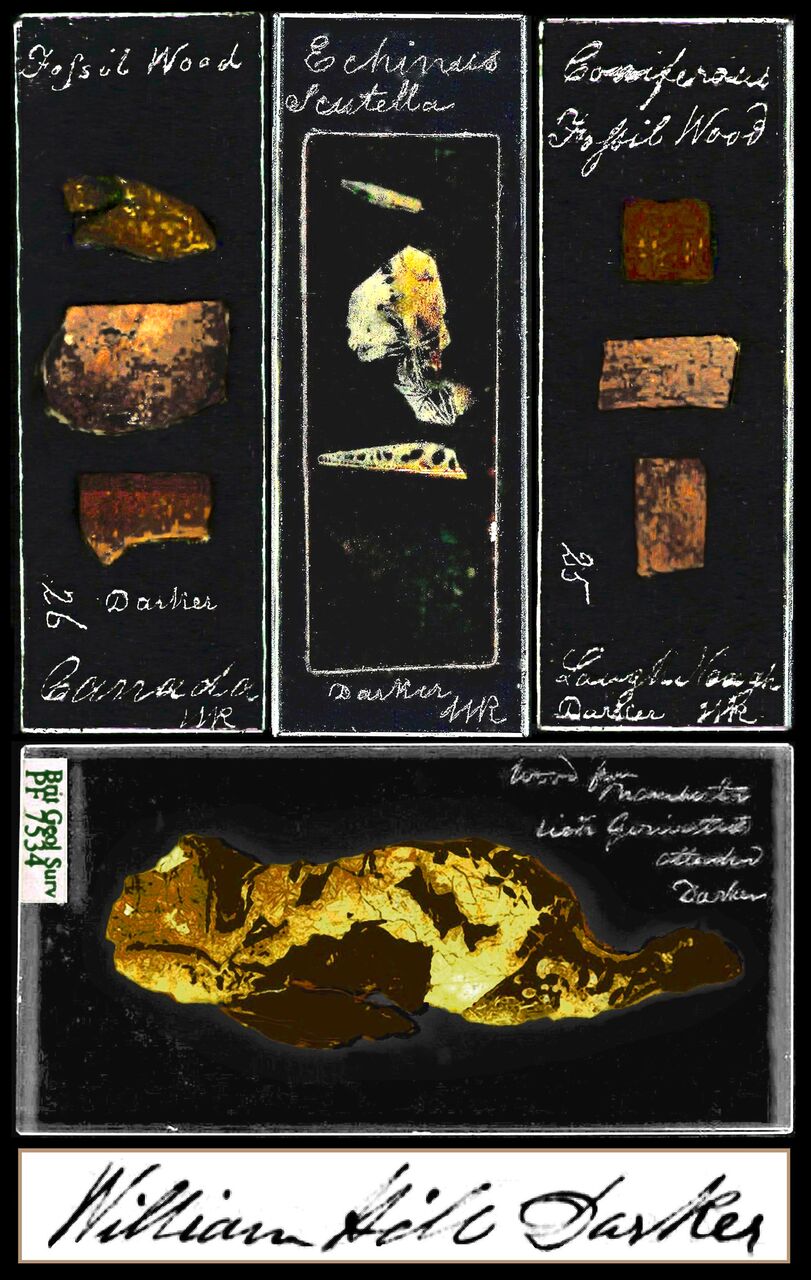
Figure 4.
William Hill Darker’s signature; from the parish record of his 1838 marriage to Grace Adams Warden, and engraved on 4 of the distinctive lapidary preparations he was known for. The bottom example (with British Geological Survey label), is one of the preparations recently found as part of the “Hooker ~ Darwin Collection”, rediscovered in 2012. Surviving examples with Darker’s engraved signature are rarities; most of his slides are unsigned.
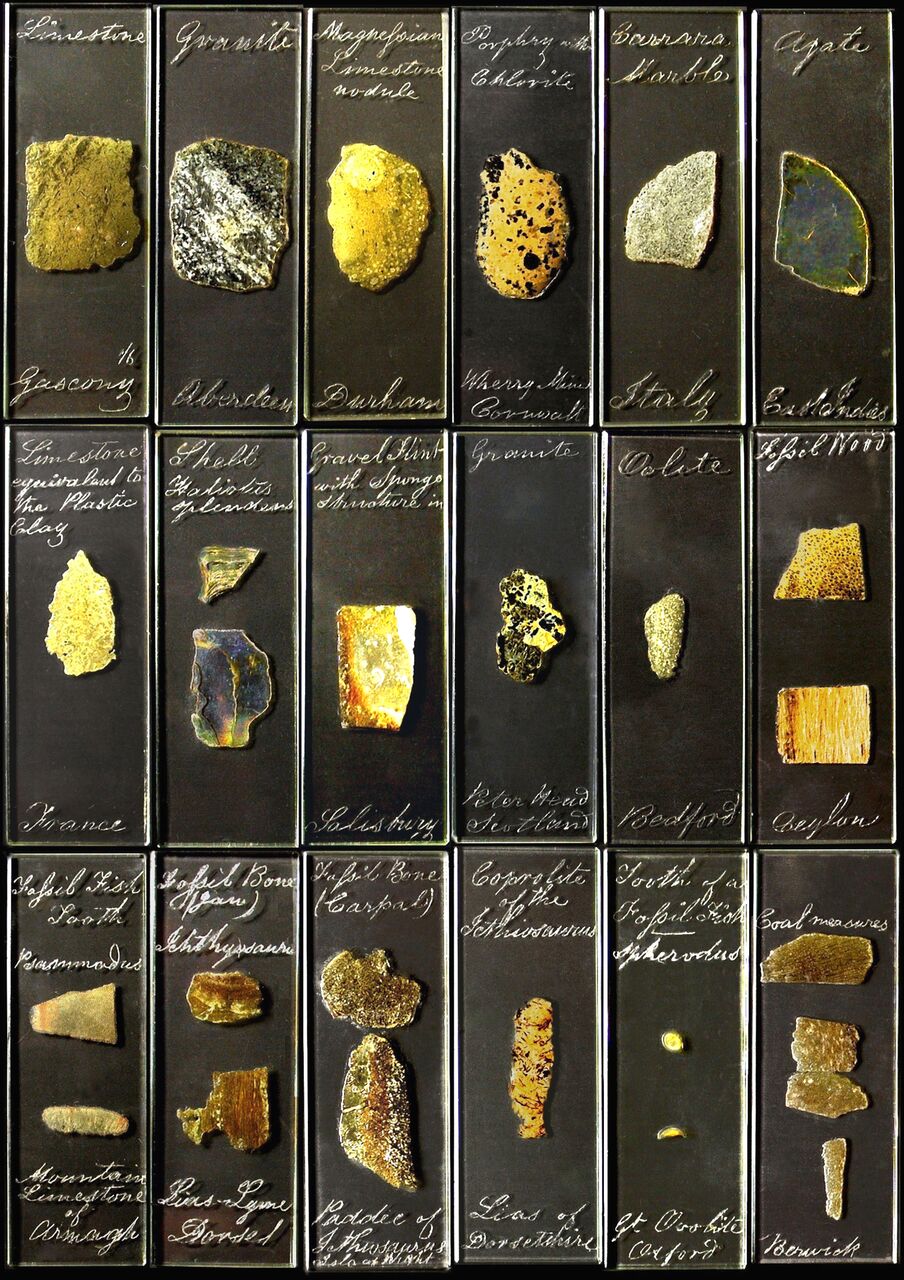
Figure 5.
Examples of lapidary slides by William H. Darker. He prepared fine thin section mounts of mineral and fossil specimens, sourced from locations worldwide.
From an early start, Darker’s lapidary slides were widely regarded. George F. Richardson’s 1843 Geology for Beginners recommended, “Objects for microscopic investigation, both recent and fossil, are prepared by Mr. Topping, York-place, Pentonville, Islington; and by Mr. Darker, 9, Paradise-row, Lambeth” (Richardson, 1843). Gideon Mantell’s Thoughts on Animalcules stated, “Mr. Darker, Paradise Row, Lambeth, is an excellent artist, and well known for the neatness and finish of his microscopical preparations and instruments, objects for the polarization of light, &c.” (Mantell, 1846). Regarding Mantell’s comments, we have identified slides of infusiora (diatoms) and other natural history specimens that were likely made by Darker (Figure 6). Not generally remembered for such preparations, it is probable that other examples survive in collections, but have been overlooked.
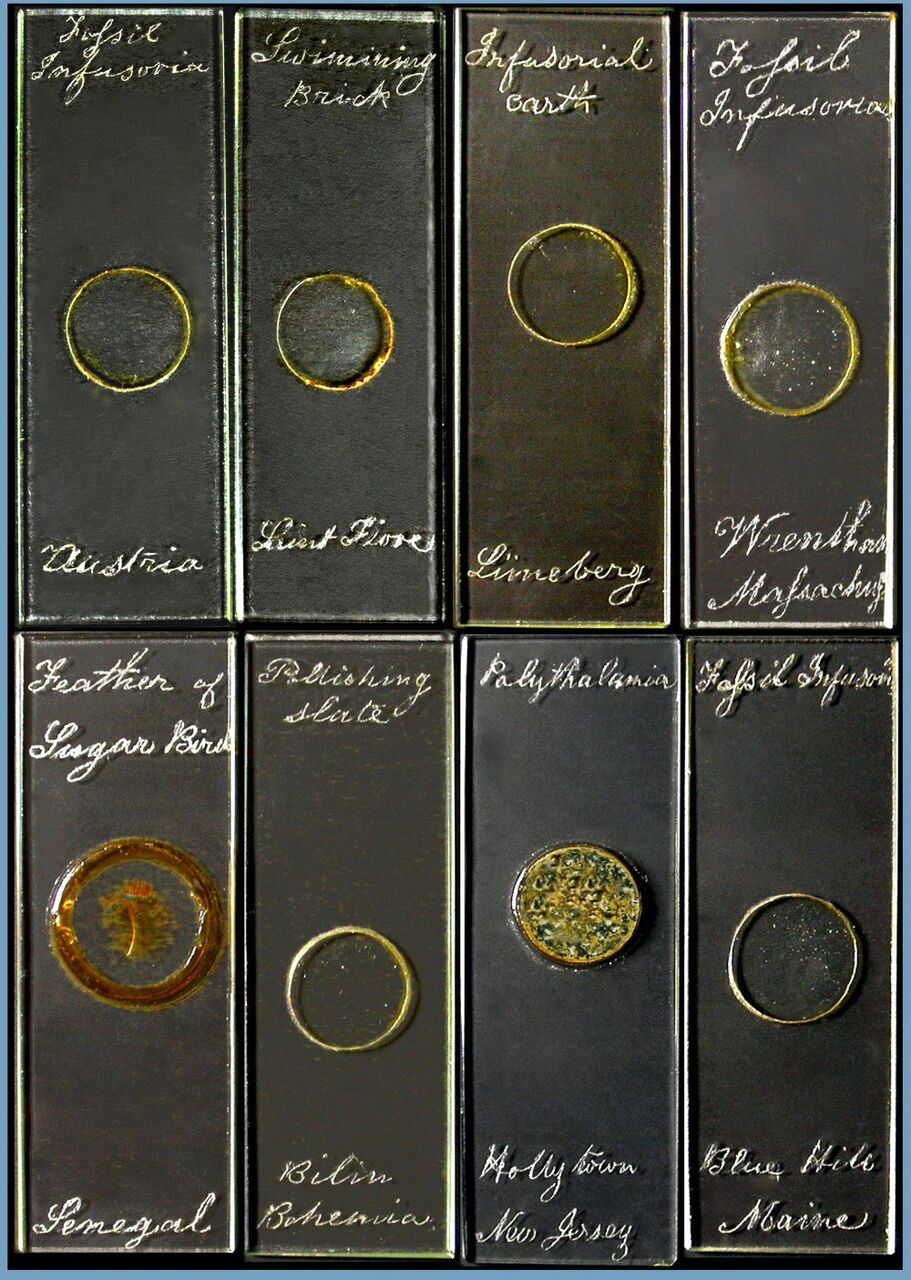
Figure 6.
Microscope slides of diatoms and other natural history specimens, which bear handwriting and construction features attributing their production to William Darker.
His microscopic lapidary work led Darker to several important paleontological discoveries. The Reverend J.B. Reade announced in 1839 that “A few weeks ago a single (fish) scale was discovered by Mr. Darker upon a fragment of flint which he had selected for a supply of the Xanthidium” (Reade, 1839). Fossils of xanthidia desmids in flint later became common commercial microscopic preparations, produced by several slide-makers. The Reverend Professor William Buckland’s February 19, 1841 address to the Geological Society of London included, “a microscopic examination of the Stonesfield slate by Mr. Darker, and of other oolites, has recently shown them to be crowded with remains of organized bodies, invisible to the naked eye” (Buckland, 1841). Mantell wrote, “In some slices of flint prepared by Mr. Darker from the Paramoudra of Ireland, polythalamia are very numerous. The shells or cases invariably appear to be silicified, and the cells of the dead shells to be filled with flint” (Mantell, 1845). Joseph Hooker exposited on a type of mineral charcoal, “I had the good fortune to meet with a fragment of the fossil wood to which these charcoals belong. In examining the collection of Mr. Darker, an acute observer and excellent lapidary, he showed me relics of a small rolled nodule of fossil wood from the coal-seams of the Yard Mine, Durham, in which I at once recognized this tissue, of which I had been long in search. The nodule was little larger than a hasel-nut, and originally covered with quartz crystals. Mr. Darker had himself conjectured its probable alliance to Cycadea” (Hooker, 1848).
According to John Quekett, a well-respected authority on microscopy, William Darker was responsible for developing a distinctive type of microscope slide (Figures 7 and 8). Quekett described “Mr. Darker’s method”: “Objects, such as sections of wood, that do not require a high power for their examination, may be mounted in a very neat way after an excellent plan first practised by Mr. Darker. The following description, abridged slightly from that given in a recent work, entitled Microscopic Objects, will convey a good idea of the method to be adopted for this purpose: ‘Two slides of equal size being selected the edges of each should be bevelled off on the metal plate … so that when they are put together a groove or channel is formed ... The surfaces having been cleaned, the bevelled parts are to be coated with a thin layer of sealing-wax varnish, when this is dry, a label, if required, may be gummed to the bottom slide, and then the objects laid on it; if it be necessary to keep them in place, the smallest possible quantity of gum may be applied to one corner; the top plate is now to be laid on the specimens, one of the edges is then to be heated in the flame of a spirit lamp, and the groove filled with sealing-wax, as shown at a; when one edge is done, the others are to be heated in the same manner, until the entire groove is filled with the wax, which thus acts two purposes, one to keep the slides together, and the other to prevent the access of air. The excess of wax may be cleaned off from the edges by rubbing them upon sand-paper laid on a flat board, until they are smooth; if bright edges be required, they may be passed quickly through the flame of the spirit lamp” (Quekett, 1852).
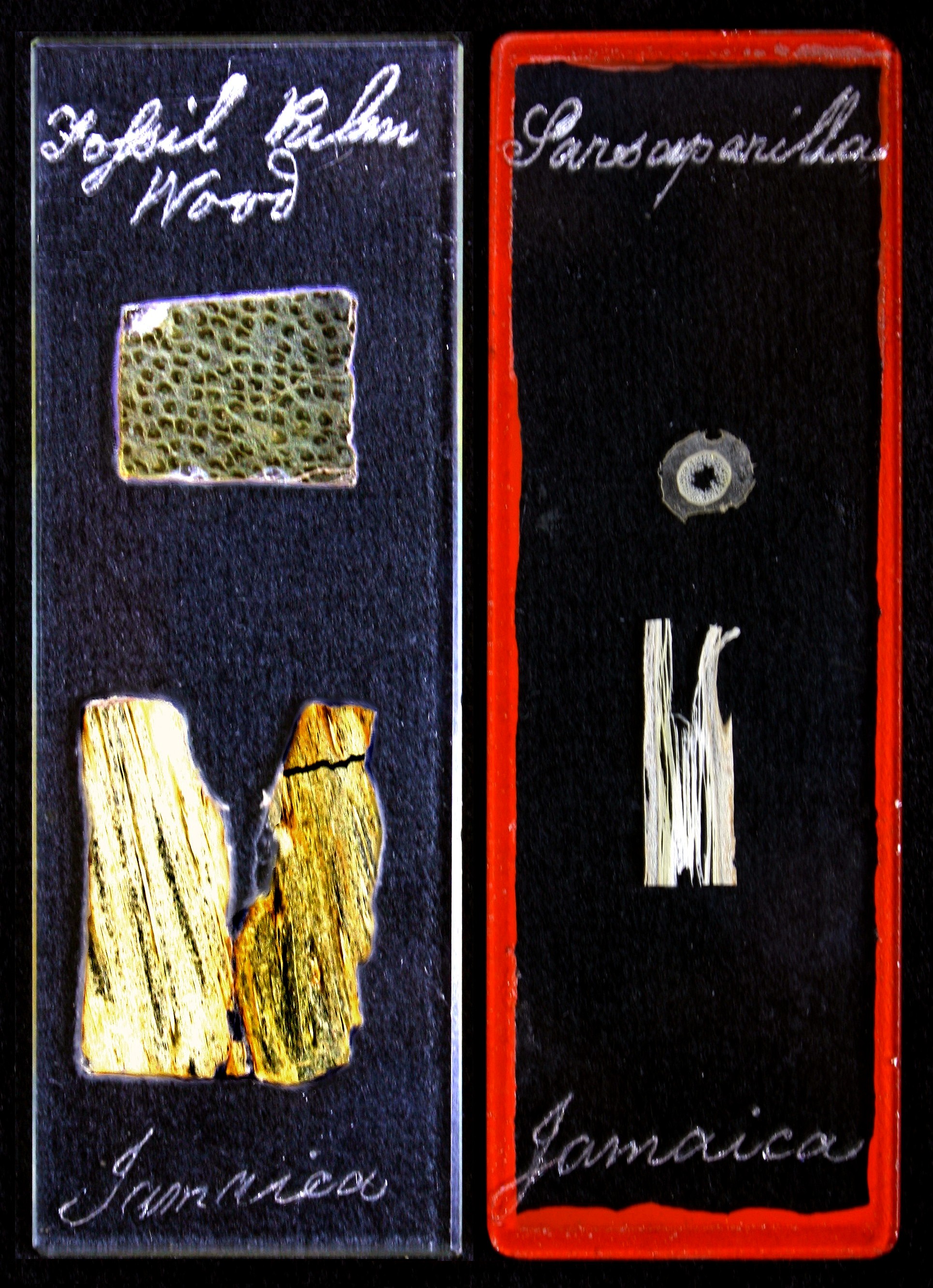
Figure 7.
Two microscope slides attributable to William Darker, based on the handwriting and construction. The left is a lapidary mount of fossil palm wood, the right used “Mr. Darker’s method” to mount fresh sarsaparilla wood sections. Note the similarities of the word “Jamaica”.
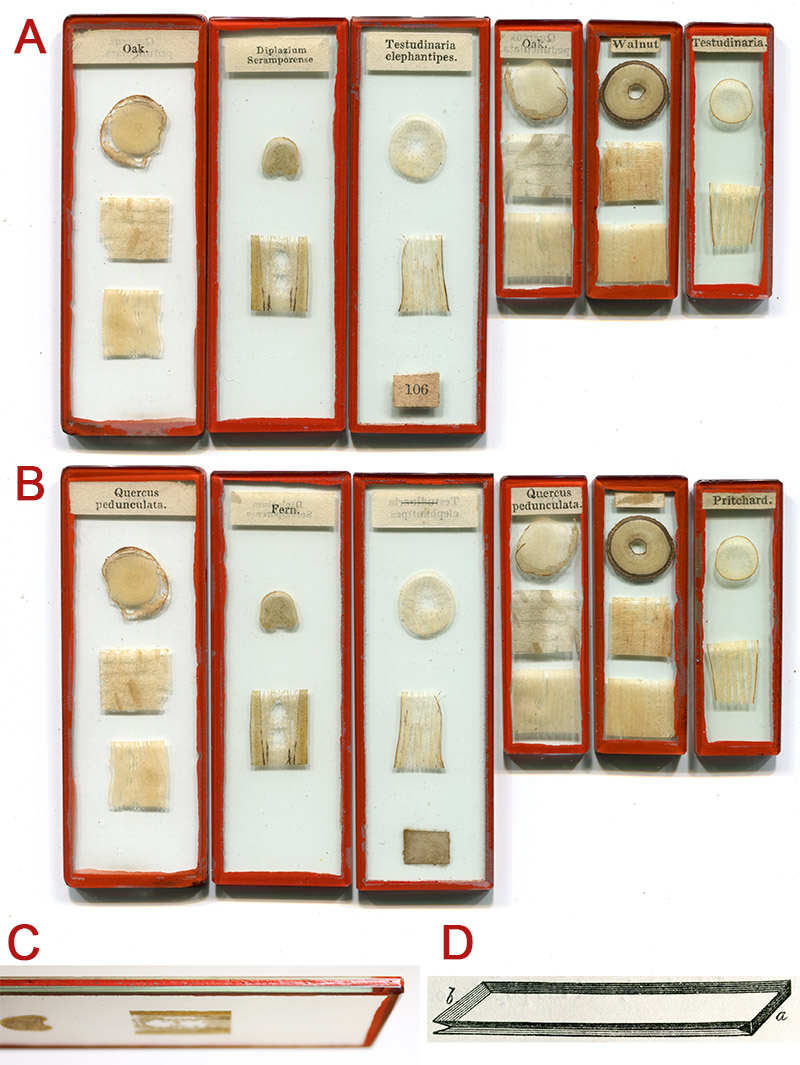
Figure 8.
(A and B) Front and back views, respectively, of microscope slides of wood sections prepared by “Mr. Darker’s method”, in both standard (1 x 3 inch) and continental sizes. These examples match those in Quekett’s 1852 list of Darker’s wood preparations (Figure 8). This type of slide is occasionally found with Andrew Pritchard’s name on a piece of paper between the two glass slips, indicating retail, but not necessarily manufacture, by Pritchard.
(C) Edge view, showing the finely chamfered and polished edges and corners, and the groove where the glass slides meet, which facilitates penetration of the sealing wax for a strong bond.
(D) Figure 214 from Quekett, 1852, described as “Two slides of equal size being selected the edges of each should be bevelled off on the metal plate as represented by fig. 214, so that when they are put together a groove or channel is formed, as shown at b in the figure.” This channel for the sealing wax is the most distinctive feature of Darker’s method, resulting in a strong bond between the glass slides. Earlier slide-makers did not grind wax channels, but instead applied sealing wax to straight-edged glass slips, forming a weaker, fragile bond between the glasses (Gould, 1829).
Further supporting Quekett’s attribution, his 1852 (second) and 1855 (third) editions of A Practical Treatise on the Microscope, state, “Mr. Darker has long been known to microscopists for his skill in making sections of wood. From the time the achromatic microscope was first employed, he mounted sets of sections made in three different directions, between glasses, in the dry way, described in page 317 (our note: i.e. Mr. Darker’s method). These served to illustrate the structure of the principal families of plants, and the popular as well as generic and specific names are printed on small labels, and introduced between the glasses”. This is followed by a list of common and Linnaean plant names, which correspond with known wax-sealed microscope slides of woods (Figure 9). Quekett also wrote, “The author, some years ago, was presented with a collection of sections of wood by Mr. Darker, which have not only kept in their places, but are as perfect and as free from confervae as when they were first received. They are all labelled after a very excellent plan, viz., by having the generic and specific name on one side of the label, and the popular on the other”. These comments from Quekett, and examples of such slides retailed by Pritchard (and datable by his shop addresses), indicate that Darker had been preparing slides with this method since the mid 1830s.

Figure 9.
List of preparations of woods produced for the microscope by William Darker, from John Quekett’s 1852, second edition of ‘A Practical Treatise on the Microscope’, pages 403-405. “page 317” refers to “Mr. Darker’s method” of preparing microscope slides.
The author of Microscopic Objects, from whom Quekett borrowed, was Andrew Pritchard (Pritchard, 1847). Some surviving slides that were made by Darker’s method carry Pritchard’s name, which has led to the assumption that the latter man was the maker. However, Quekett’s testimony, and absence of Pritchard’s name from the majority of such slides, argue for Darker as the actual source. Pritchard was astute at self-promotion and occasional truth-stretching, to the extent of claiming that he invented the use of Canada balsam as a mountant: his anonymously-published Microscopic Objects states, “We are indebted to Mr. Pritchard for the suggestion of this superb mode of embalming” and cites his 1832 Microscopic Cabinet, which does not actually describe the use of balsam for such purposes (Pritchard, 1832). Yet, despite his tendency to exaggerate, Pritchard did not lay claim to the invention of using wax to seal microscope slides. On a related note, Pritchard is known to have sold microscope lenses and slides made by outside suppliers, including Powell, Nachet, and Bourgogne (Nuttall, 2006).
Quekett further described a Darker invention that allowed rotation of selenite discs while under the microscope (Figure 10). “Selenite, from the circumstance of its splitting easily into laminae, may be obtained of all thicknesses … the same variety of tints may be produced by placing the films one over the other; for this purpose, Mr. Darker, who has paid considerable attention to the subject of polarized light, and to whose ingenuity we are indebted for some of the most beautiful of our apparatus for exhibiting certain phenomena in connection with this subject, has constructed for Dr. Leesing the instrument … It consists of a plate of brass, four inches long, an inch-and-a-half broad, and one-fifth of an inch thick, having a piece of raised brass screwed to it, against which objects may rest when the microscope is inclined; in the centre of the brass plate there is a hole, one inch in diameter, into which is fitted a ring of the same metal, with a shoulder on its under side to receive certain cells, into which plates of selenite are fitted; this ring is capable of being revolved either to the right or the left of a central index or dart, by means of an endless screw, turned by the small handle seen on the right side of the figure. PA 1/4 , PA 2/4, PA 7/4, represent three brass cells, into each of which are burnished two plates of thin glass, having between them films of selenite of different thicknesses. The dart at PA denotes the direction of the positive axis of the selenite, and the figures 1/4, 2/4, &c., denote the parts of a vibration retarded by each disc, which, by their super-position and variation in position, by means of the endless screw motion, produce all the colours of the spectrum”.
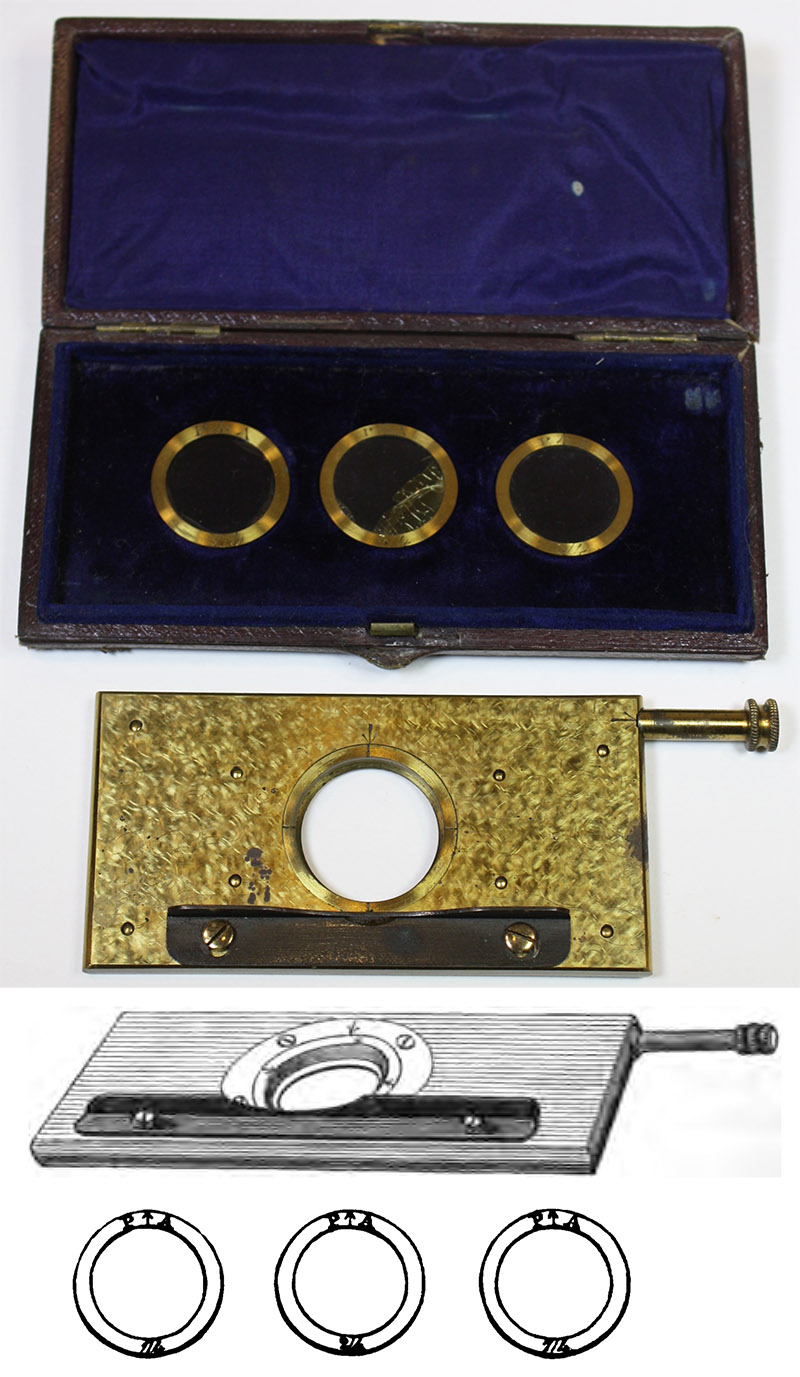
Figure 10.
“Darker’s revolving selenite stage”. (top) an extant set of selenites and revolving stage; (bottom) engravings from John Quekett’s 1852, second edition of A Practical Treatise on the Microscope, page 250.
Quekett also described a glass cell for microscope slides, “Mr. Darker has ingeniously contrived a cell of the form represented. These cells are cast in glass … , and, in order to prevent the cement from running in, the sides are constructed as shown by G D B; B being the outer margin of the cell, D a flat surface for the cover to rest on, and G a groove between it and the inner margin. These cells are cemented to the slides in the usual manner, either with marine-glue or asphaltum dissolved in turpentine, the method of cementing down the cover is the same as in the other forms, a small quantity of gold-size being applied around its edge either with a brush or the finger before it is placed on the fluid within the cell; should there be any tendency in the cement to run under the cover, it must first fill up the groove before it can get into the cavity where the object is. The under surface of this form of cell can be ground sufficiently thin to enable a quarter of an inch object-glass to view any object contained within it” (Figure 11).
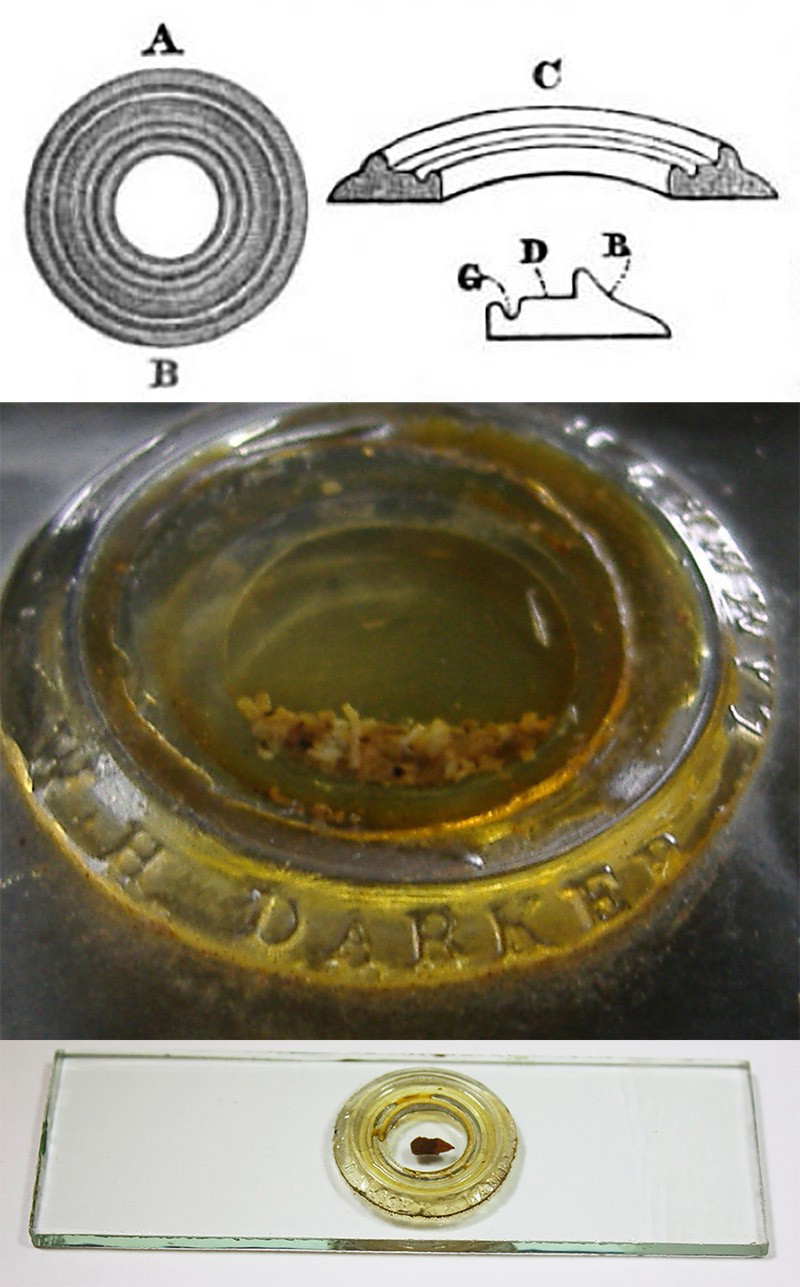
Figure 11.
Darker’s glass cells for microscope slide preparations. Top, illustration from John Quekett’s 1852, second edition of A Practical Treatise on the Microscope, page 285; Middle and bottom, surviving glass cells. Each is embossed “W.H. Darker Lambeth”.
Professional frustrations and tragedy
Above, we quoted several famous scientists on Darker’s frustratingly slow time-to-delivery. This was likely due partly to Darker’s perfectionism, and partly to his tendency to focus on work that interested him scientifically rather than money making ventures. Some insight is provided by a series of letters to Charles Bancker, an American collector of scientific instruments, from his London agent, Robert Watson. In 1844, Watson wrote, “Mr. Darker is chiefly employed by the principal philosophical apparatus houses, and has made (he doubts not) many of the articles you have procured through Jones and others. At first he seemed reluctant to undertake anything except through the houses; but, after a little conversation, I induced him to assent, promising on my part, immediate payment for whatever he might supply … Mr. Darker is quite a genius in his art and … can effect objects which scarcely another man in London can be found to do … Mr. Darker is much occupied and will frequently require more time than he has taken on the present occasion”. Two years later, Watson wrote, “With regard to Mr. Darker I am sick of him, though I suppose he must be excused on the plea of the irregularity of genius!”, and “As for Darker, I fear he is too much occupied with, and interested (philosophically) in experiments which he makes for Professors Wheatstone and Faraday, that whatever he may promise and intend, little reliance can be placed on his promises” (Simpson, 1995).
William Crookes and Charles H.G. Williams learned, to their chagrin, that it sometimes pays to wait for the best quality. Williams needed a new optical instrument in 1861, which Crookes arranged to have built. Progress is marked in a series of letters from Crookes to Williams. February 28: “I have had a long consultation with a very intelligent instrument maker … Please say whether the above will suit your views … I will then set the maker to work at once. Darker is by far the best man to go for anything of the sort but he keeps people waiting for 18 months or 2 years!” March 7: “Mr. Ackland at Horne and Thornthwaite’s is making the apparatus. I saw it yesterday. It will be finished in about a week now”. April 1: “First about your apparatus, it came in due time and I devoted an evening to its study. It was not so perfect as I think it could be made, so I took a sheet of paper and found every possible fault with it, stating the best remedy … It is a great bore that it cannot be made right at first”. April 4: “I devoted some hours yesterday afternoon, at Horne & Thornthwaite’s, to adjustment of your apparatus. The long paper of faults which I sent them last week has been attended to and I found a considerable improvement; altho’, they had tried to be too clever and had so taken the trouble to regrind all the lenses and put in achromatics (and as we want all the colour possible this is not only a needless expense, but is positively injurious”. April 13: “Respecting your apparatus, do not keep it unless you are thoroughly satisfied with it. Send it back and Ackland will easily get rid of it to someone else … and will make you a better one, or he will do anything in the matter you propose as to altering it &c.” (James, 1981).
The impact of Darker’s flightiness and perfectionism on his business relationships and reputation can be seen in an October 5, 1858 letter from Sir George Stokes to Lord Kelvin, “I called on Darker this evening, and not finding him at home I have left the mirror with his son and I have just written to him on the subject…I dare not suggest any doubts to Darker lest he should put off the making: if you can get him to do it by the first intention that’s your best chance” (Wilson, 1999).
In our prologue, we quoted a frustrated letter from Kelvin to Stokes. Kelvin wrote again, “Is Mr. Darker in existence? I bought & paid for a hydroelectric machine, which I saw in its packing box last June year but it has never come. I am going to put it into a solicitor’s hands to recover my property, unless I see my way of getting it otherwise, as I have sent to Mr. Darker letters without getting answers till I am tired”. The delay in delivery was due to Darker’s continued testing of the apparatus, and to a disaster at his shop. Stokes wrote back to Kelvin, “Darker had a sad accident about a hydroelectric machine, whether yours or not I am not sure. He was trying it, I think with a pressure less than to which it had previously been exposed, when it burst. Darker himself was knocked on the head, but not much hurt, but one of his best workmen was struck, and though apparently not severely hurt, he died of it the next day” (Wilson, 1999). That accident occurred on September 2, 1852. Newspaper accounts identify the deceased as Charles Noble Farebrother, aged 30 years. “Harry Sexton, a brass finisher, stated that he had known the deceased about three years, and had worked in the service of Mr. Darker. On Thursday afternoon last, the deceased had charge of a wrought iron boiler, which was intended for an hydroelectric machine, ordered for University College, Cambridge … The deceased was at a forge about three o’clock in the afternoon, and had charged the boiler (which was only nine inches in diameter) with the usual quantity of water for the purpose of testing it, when the witness said, ‘Charley, how is the steam?’, when the deceased replied ‘Oh, just up’. Witness left the forge to go to the vice, when Mr. Darker entered the shop, and in about a minute afterwards a loud explosion took the place. Witness ran towards the forge, but the smoke and dust were so thick he could not see them for a few minutes. The forge was blown down, and a portion of the roof had been carried away … Witness then discovered the deceased nearly covered over with bricks and rubbish … Mr. Darker was also much injured about the head and body, and at present lying in a very dangerous state.” (The Morning Post, 1852).
William Hill Darker’s personal life
Darker suffered several disappointments and tragedies in his life, although there were undoubtedly bright times. William married Grace Adams Warden on May 25, 1838. Grace was the daughter of John Warden, a warden of the Royal Mint in the Tower of London. The couple had four children: William Hill Darker (born March 16, 1839), Charles John Darker (born January, 1841). Francis Henry Darker (born August 16, 1843), and Grace Jane Darker (born February 25, 1846). Sons Charles and Francis inherited their father’s business, continuing for many years as the successful C. & F. Darker (Figure 13).
Grace was not at home during the time of the 1841 national census. Noting that son Charles was born four months before that census was taken, it is possible that Grace had hired out as a wet nurse: the 1841 census records a “Grace Adams”, of the same age as Grace Darker, working as a servant in nearby Rotherhithe for a family that had a seven month-old son.
The Darkers' eldest son died of scarlet fever in February, 1848, when he was only 8 years old.
Grace turned to drinking, to the extent that William separated from her by 1850. The March 25, 1850 issue of The Globe reported: "Lambeth, this day - Grace Darker, a woman of respectable appearance, but who, it seems, is much given to intemperate habits, was charged before Mr. Norton with being drunk, and causing a considerable disturbance at the house of her father-in-law. Mr. Wm. Hill Darker, of Paradise-street, Lambeth, stated that on Saturday evening, about six o'clock, the prisoner, who was the wife of his son, came to his house and created a disturbance, quite alarming the neighborhood. She has been given to intemperate habits, and was much intoxicated at the time. Her son was obliged to separate from her on account of her conduct and propensity to drink, and she was quite drunk at the time she came to his house on Saturday evening. Police constable Wm. Curtis said that when the prisoner was given into his custody she was quite drunk and noisy. The prisoner expressed great contrition for her misconduct, and on her solemn promise to keep sober and not again disturn her father-in-law, she was discharged, with a severe caution as to her future conduct."
Separated from her family, and presumably still drinking to excess, Grace's life spiralled downward. On March 30, 1851, the date of the national census, she was a “criminal prisoner” in the Surrey County Gaol. The nature of her crime is not known. She lived in the Princes Road Workhouse from April 30 to May 5, 1852 and from November 27 to December 21, 1853, a situation that implies extreme poverty. She worked as a "laundry woman" at the same workhouse during 1855. In June, 1862, an announcement was posted in a local newspaper asking Grace Darker to apply to 93 Southwark Bridge Road "where she will hear of something to her advantage from her sister". It is not known whether Grace was alive at that time. No further record of Grace has been located.
William’s father (and business partner) died in 1851, and his mother died in 1862. William had lived his entire life with his parents, so their losses would probably have been especially difficult. Adding in the death of his first-born child, the estrangement from his wife, the near-fatal accident of 1852, and continual poverty brought on by his scientific exploits, then it is no wonder that John Tyndall considered Darker’s life to be “a struggle”. It eventually became too much for him to bear. William Darker killed himself on April 13, 1864, “by shooting himself with a gun, (while) labouring under mental aberration” (Death record, 1864).
Alfred Varley wrote, “I remember also when Mr. Darker died, a man whose name is probably almost unknown to the present generation, but who had rendered great assistance to Wheatstone in the very early days of telegraphy, and also to Faraday, Tyndall, and others, a public reference was made to his special abilities. Darker, wearied out and exhausted with assisting others, ended his own life at last by shooting himself. It was my fate to see him shortly before he committed suicide, for he paid me a visit - the only time I think he did so - in the small hours of the morning and opened his heart to me, telling me he was wearied out and wanted to get away from himself, and he told me he had got quite a small library of scientific books presented to him by their authors, in recognition of assistance he had rendered them, he said he had called thinking I might be able to get him a berth and send him to New Zealand or to Australia in the course of the day already begun. I tried to persuade him to have some supper with me, and I temporised to some extent, telling him although I could not myself pack him off to Australia, I thought it just possible my brother could help him in the matter, for cool and collected as he was, I recognised the highly wrought condition he was in, and that something was wrong; but at the same time the idea of such a man committing suicide never once occurred to me; but this I found he had done by seeing an account of the inquest in the public papers” (Varley, 1891).
Conclusion
By all accounts, William Darker had a keen mind, and was an observant scientist and a skilled engineer. The invitation to become a charter member of the Microscopical Society of London demonstrates the esteem in which he was held. Darker was no mean tradesman, he was a colleague to many of the scientific community. Even so, he does not appear to have been an equal: Darker operated the projection lantern while Faraday lectured, and investigators hounded him to produce equipment for their own experiments. One wonders how famous Darker would have become, and what he may have discovered, if he had the wealth and independence of his customers?
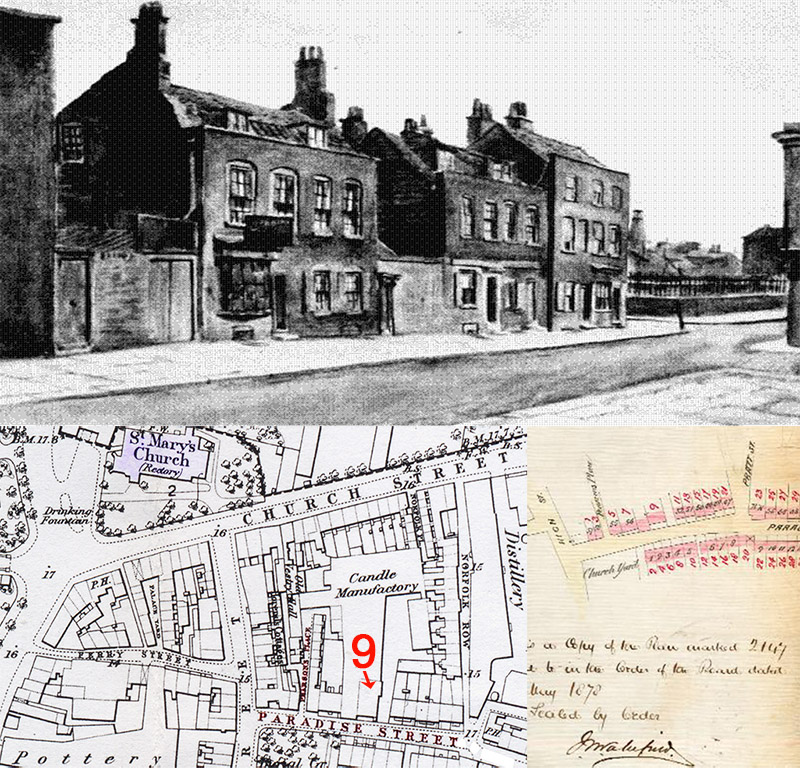
Figure 12.
A circa 1870 photograph of the intersection of High and Paradise Streets, Lambeth, and two contemporary maps of the area. The view in the photograph is looking south on High Street. Paradise Street is the left turn, after the last house. The Burial Grounds lie on the other side of Paradise Street. The Darkers lived and worked at 9 Paradise Street.

Figure 13.
W.H. Darker’s calling card, collected during the 1862 London International Exhibition. adapted for nonprofit, educational purposes from https://novascotia.ca/archives/honeyman.

Figure 14.
A projection kaleidoscope that was made by William Darker’s sons, Charles and Francis. It consists of two long mirrors, set at a 60 degree angle to each other. Light shining down the tube produces a 6-fold reflection of the projected image.
Acknowledgements
We thank Steve Gill and Gary Kent for their helpful genealogical research, Barry Sobel for providing images of rare signed Darker preparations from his collection, Pete Hodds for directing us to Darker’s calling card.
Additional examples of works by W.H. Darker and other microscopists can be found at the Howard Lynk’s internet resource site, http://www.victorianmicroscopeslides.com
and
http://www.victorianmicroscopeslides.com/mounters/whdarker.htm
References
The Adelaide Street Gallery for the Exhibition of Objects Blending Instruction with Amusement, Adelaide Street, and Lowther Arcade, West Strand, Catalogue for May (1836) Fourteenth Edition, Society for the Illustration and Encouragement of Practical Science, pages 45-46, and 51
Bowerbank, J.S. (1870) Reminiscences of the early times of the achromatic microscope, The Monthly Microscopical Journal, 3:281-285
Bowers, B. (2001) Sir Charles Wheatstone FRS: 1802-1875, Institution of Electrical Engineers, London, page 207
Buckland, W. (1841) Address, Proceedings of the Geological Society of London, 3:508
Cooper, D. (1835) Nedttia spiralis Swz., The Magazine of Natural History, 8:636-637
Cooper, J.T. (1820) Analysis of zinc ores, Quarterly Journal of Science, Literature and Art, 9:191-192
Cooper, J.T. (1831) On the method of observing the fixed lines in the solar spectrum, Journal of the Royal Institution of Great Britain, 2:289-292
Cooper, J.T. (1836) Some remarks on hydrocyanic acid, London and Edinburgh Philosophical Magazine and Journal of Science, 14:186-187
Davidson, B. (2009) John New and the introduction of Canada balsam into slide-making, Quekett Journal of Microscopy, 41:95-108
Death record of William Hill Darker (1864) obtained from the National Archives
Falcon-Lang, H.J., D.M. Digrius (2014) Palaeobotany under the microscope: history of the invention and widespread adoption of the petrographic thin section technique, Quekett Journal of Microscopy, 42:253-280
Field, G. (1845) Chromatics: or, the Analogy, Harmony, and Philosophy of Colours, Bogue, London, page 256
The Globe (1850) "Lambeth - this day - Grace Darker...", March 25, page 3
Gould, C. (1829) The Companion to the Microscope, 6th edition, W. Cary, London
Gray, S.F. (1828) The Operative Chemist, Hurst, Chance, & Co., London
Hartog, P.J. (1899) Warington, Robert, Dictionary of National Biography, 1885-1900, Vol. 59
Hooker, J. (1848) On the vegetation of the Carboniferous Period, as compared with that of the present day, Memoirs of the Geological Survey of Great Britain, 2:387-430)
Hunt, R. (1862) Handbook to the Industrial Department of the International Exhibition 1862, Vol. 1, Edward Stanford, London, page 193
International Exhibition, 1862: Medals and Honourable mentions Awarded by the International Juries (1862), 2nd ed., Eyre and Spottiswoode, London, page 197
James, F.A.J.L. (1981) The letters of William Crookes to Charles Hanson Greville Williams 1861-2: The detection and isolation of thallium, Ambix, 28:131-157
James, F.A.J.L. (1993) The Correspondence of Michael Faraday, Vol. 2, Institution of Electrical Engineers, page 505
Leifchild, J.R. (1860) Coal and coniferous wood under the microscope, Recreative Science, 1:343-344
Littell’s Living Age (1846) Royal Institution, Jan. 23, 9:197
London Gazette (1813) Report of the dissolution of the partnership between William H. Darker and Charles Kirkham, page 560
London Journal of Arts and Sciences (1823) 4:45
London Mechanics’ Register (1826) Dr. Birbeck’s lecture on telescopes and microscopes, 3:66-71
Mantell, G.A. (1845) On the animalculites of the chalk and flint of the south-east of England, The Annals and Magazine of Natural History, 103:72-86
Mantell, G.A. (1846) Thoughts on Animalcules, J Murray, London, pages 111-112
Mechanic and Chemist (1839) London Mechanics’ Institution, lectures to be delivered during the quarter, 28:224
The Morning Post Saturday (1852) Alarming explosion and loss of life at Lambeth, September 4
Museum of the History of Science, Oxford, Inventory number 14506, http://www.mhs.ox.ac.uk/collections/search/display-narrative/?irn=8144&index=0
Nicol, W. (1828) On a method of so far increasing the divergency of the two rays in calcareous-spar, that only one image may be seen at a time, The Edinburgh New Philosophical Journal, 5:83-84
Nicol, W. (1834) Observations on the structure of recent and fossil conifers, The Edinburgh New Philosophical Journal, 15:137-157
Nuttall, B. (2006) Marketing the achromatic microscope: Andrew Pritchard’s engiscope, Quekett Journal of Microscopy, 40:309-330
Palmer, Edward (1840) Palmer’s New Catalogue, printed by W Gilbert, London
Pepper, J.H. (1860) The Boy's Playbook of Science, 2nd edition, Routledge, Warne, and Routledge, London, page 346
Periera, J. (1854) Lectures on Polarized Light, 2nd edition, Longman, Brown, Green and Longmans, London, pages 60 and 135-136
Pharmaceutical Journal (1849) Transactions of the Pharmaceutical Society, 8:368
Pritchard, A. (1832) The Microscopic Cabinet, Whittaker, Treacher, and Arnot, London
Pritchard, A. (1842) English Patents: Being a Register of all Those Granted for Inventions in the Arts, Manufactures, Chemistry, Agriculture, &c, In the Year 1841, Whittaker, London
Pritchard, A. (1847) Microscopic Objects, Whittaker and Co., London
Proceedings of the Institution of Electrical Engineers (1876) 5:90
Quekett, J. (1852) Practical Treatise on the Use of the Microscope, Second edition, H. Balliere, London
Quekett, J. (1855) Practical Treatise on the Use of the Microscope, Third edition, H. Balliere, London
Reade, J.B. (1839) On organic remains, The Annals and Magazine of Natural History, 2:194-195
Report of the Seventh Anniversary of the Microscopical Society of London, Held at the Society’s Rooms, No. 21, Regent Street, February 10th (1847) page 26
Richardson, G.F. (1843) Geology for Beginners, Longman, Brown, Green and Longmans, London, page 123
Simpson, A.D.C. (1995) ‘La plus brilliante collection qui existe au monde’, a lost American collection of the nineteenth century, Journal of the History of Collections, 7:187-196
Stevenson, B., B. Davidson, P. Paisley and H. Lynk (2010) Nineteenth century microscope slide mounters JWB and JB: their work and their identities, Quekett Journal of Microscopy, 41: 203-217
Stevenson, B., and H. Lynk (2016) William Hill Darker: The scientists’ engineer, Quekett Journal of Microscopy, 42: 559-579
Times (London) (1833) Beautiful experiments on the hydro-oxygen microscope, reprinted in The Young Mechanic, 1833, 2:115-116
Tyndall, J. (1879) The electric light, The Fortnightly, 25:197-216
Varley, Samuel A. (1891) Posthumous scientific honors, The Telegraphic Journal and Electrical Review, 28:239-240
Wilson, D.B. (1990) The Correspondence Between Sir George Gabriel Stokes and Sir William Thomson Baron Kelvin of Largs, vol.1, 1846-1869, Cambridge University Press, Cambridge, pages 67-68, 104, 107, 108, 130, 134, 136, 146, 213, and 235
Witham, H.T.M. (1831) Observations on Fossil Vegetables Accompanied by Representations of Their Internal Structure as Seen Through the Microscope, Blackwood, Edinburgh
Genealogical records, vital statistics, tax records, etc., of England and Scotland were accessed through ancestry.co.uk. These included a family tree that includes George Sanderson, http://trees.ancestry.co.uk/tree/7012274/person/-1122233604?ssrc=














